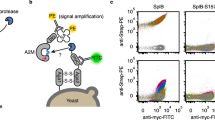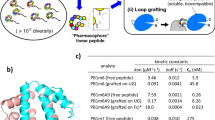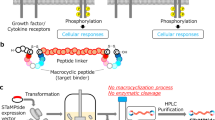Abstract
Low-molecular-weight synthetic molecules that mimic the activity of native biological macromolecules have therapeutic potential, utility in large-scale production of biopharmaceuticals, and the capacity to act as probes to study molecular recognition events. We have developed a nonpeptidyl mimic for Staphylococcus aureus Protein A (SpA). The specific recognition and complexation elements between the B domain (Fb) of SpA and the Fc fragment of IgG were identified from the x-ray crystallographic structure. Computer-aided molecular modeling was used to design a series of biomimetic molecules around the Phe132-Tyr133 dipeptide involved in its binding to IgG. One of the ligands binds IgG competitively with SpA in solution and when immobilized on agarose beads, with an affinity constant of 105-106 M−1. The immobilized artificial Protein A was used to purify IgG from human plasma and murine IgG from ascites fluid, and to remove bovine IgG from fetal calf serum.
This is a preview of subscription content, access via your institution
Access options
Subscribe to this journal
Receive 12 print issues and online access
$209.00 per year
only $17.42 per issue
Buy this article
- Purchase on Springer Link
- Instant access to full article PDF
Prices may be subject to local taxes which are calculated during checkout
Similar content being viewed by others
References
Macarthur, M.W., Driscoll, P.C., and Thornton, J.M. 1994. NMR and crystallography—complementary approaches to structure determination. Trends Biotech. 12: 149–153.
Taylor, W.R. 1994. Remotely related sequences and structures—analysis and predictive modeling. Trends Biotech. 12: 154–158.
Bowen, J.R, Charifson, P.S., Fox, P.C., Kontoyianni, M., Miller, A.B., Schnur, D., et al. 1993. Computer-assisted molecular modeling—indispensable tools for molecular pharmacology. J. Clin. Pharmacol. 33: 1149–1164.
Lu, B., Smyth, M.R., and Okennedy, R. 1996. Oriented immobilization of antibodies and its applications in immunoassays and immunosensors. Analyst 121:r29–r32.
Oriuchi, N., Endo, K., Watanabe, N., Sugiyama, S., Asao, T., Takenoshita, S., et al. 1995. Semiquantitative spect tumor uptake of Tc-99m-labeled anti-CEA monoclonal-antibody in colorectal tumor. J. A/L/C/. Med. 36: 679–683.
Powell, M.C., Perkins, A.C., Pimm, M.V., Aljetaily, M., Wastie, M.L., Durrant, L., Baldwin, R.W., and Symonds, E.M. 1987. Diagnostic-imaging of gynecologic tumors with the monoclonal-antibody 791t/36. Am. J. Obstet. Gynecol. 157:28–34.
Goeser, T. and Theilmann, L. 1994. Therapy of chronic viral-hepatitis. Int. J. Clin. Pharmacol. Ther. 32: 571–576.
Spooner, R.A. and Lord, J.M. 1990. Immunotoxins—status and prospects. Trends Biotech. 8: 189–193.
Yarmush, M.L., Weiss, A.M., Antonsen, K.P., Odde, D.J., and Yarmush, D.M. 1992. Immunoaffinity purification—basic principles and operational considerations. Biotech. Adv. 10: 413–446.
Kohler, G. and Milstein, C. 1975. Continuous culture of fused cells secreting antibody of predefined specificity. Nature 256: 495–497.
Lonberg, N., Taylor, D., Harding, F.A., Trounstine, M., Higgins, K.M., Schramm, S.R., et al. 1994. Antigen-specific human-antibodies from mice comprising 4 distinct genetic modifications. Nature 368: 856–859.
Green, L.L., Hardy, M.C., Maynardcurrie, C.E., Tsuda, H., Louie, D.M., Mendez, M.J., et al. 1994. Antigen-specific human monoclonal-antibodies from mice engineered with human ig heavy and light-chain YACs. Nat. Genet. 7: 13–21.
Sparrmann, M., Ottosson, T., Magnusson, B., and Nilsson, A. 1987. Affinity-chromatography purification using protein A immobilized to traditional matrices and to hplc matrices. Biol. Chem. Hoftpe-Seyler 368–776.
Ohlson, S., Nilsson, R., Niss, U., Kjellberg, B.M., and Freiburghaus, C. 1988. A novel-approach to monoclonal-antibody separation using high-performance liquid affinity-chromatography (hplac) with selectispher-10 protein G. J. Immunol. Methods 114: 175–180.
Fuglistaller, R 1989. Comparison of immunoglobulin binding-capacities and ligand leakage using 8 different protein-A affinity-chromatography matrices. J. Immunol. Methods 124: 171–177.
Godfrey, M.A.J., Kwasowski, P., Clift, R., and Marks, V. 1993. Assessment of the suitability of commercially available spa affinity solid-phases for the purification of murine monoclonal-antibodies at process scale. J. Immunol. Methods 160: 97–105.
Porath, J., Maisano, F., and Belew, M. 1985. Thiophilic adsorption—a new method for protein fractionation. FEBS lett. 185: 306–310.
Porath, J. and Belew, M. 1987.Thiophilic interaction and the selective adsorption of proteins. Trends Biotech. 5: 225–229.
Belew, M., Juntti, N., Larsson, A., and Porath, J. 1987. A one-step purification method for monoclonal-antibodies based on salt-promoted adsorption chromatog-raphy on a thiophilic adsorbent. J. Immunol. Methods 102: 173–182.
Hutchens, T.W. and Porath, J. 1986. Thiophilic adsorption of immunoglobulins -analysis of conditions optimal for selective immobilization and purification. Anal. Biochem. 159: 217–226.
Elkak, A. and Vijayalakshmi, M.A. 1991 .Study of the separation of mouse monoclonal-antibodies by pseudobioafflnity chromatography using matrix-linked histidine and histamine. J. Chromatogr.-Biomed. Appl. 570: 29–41.
Elkak, A., Manjini, S., and Vijayalakshmi, M.A. 1992. Interaction of immunoglobulin G with immobilized histidine—mechanistic and kinetic aspects. J. Chromatogr. 604: 29–37.
Ngo, T.T. and Khatter, N. 1990. Chemistry and preparation of affinity ligands useful in immunoglobulin isolation aind serum-protein separation. J. Chromatogr. 510: 281–291.
Ngo, T.T. and Khatter, N. 1991. Rapid and simple isolation of multigram goat IgG from serum using Avid AL and radial flow column. Appl.Biochem. Biotech. 30: 111–119.
Ngo, T.T. and Khatter, N. 1992. Avid AL, a synthetic ligand affinity gel mimicking immobilized bacterial antibody receptor for purification of immunoglobulin G. J. Chromatogr. 597: 101–109.
Deisenhofer, J. 1981. Crystallofraphic refinement and atomic models of a human Fc fragment and its complex with fragment-b of protein-A from Staphylococcus-aureus at 2.9 Å and 2.8 Å resolution. Biochemistry 20: 2361–2370.
Levitt, M. and Park, B.H. 1993. Water—now you see it, now you don't. Structure 1: 223–226.
Langone, J.J. 1982. Protein-A of Staphylococcus-aureus and related immunoglobulin receptors produced by streptococci and pneumococci. Adv. Immunol. 32: 157–252.
Stead, C.V. 1989. p. 21 in Promin-dye interactions: Developments and applications. Vijayalakshmi, MA. and Bertrand, O. (ed.), Elsevier Applied Science, London.
Heunhoeffer, H. 1978. pp. 1–371 in Chemistry of 1,2,3-triazines and 1,2,4-triazines, tetrazines pentazines. Heunhoeffer, H. and Paul, F. (eds.), John Wiley and Sons, New York.
Cheng, Y. and Prusoff, W.H. 1973. Relationship between the inhibition constant (Kr) and the concentration of inhibitor which cause 50 per cent inhibition(I50) of an enzymatic reaction. Biochem. Phatmacol. 22: 3099–3108.
Rodbard, D. and Leward, J.E. 1970. pp. 79–103 in Steroid assay by protein binding. Diczfausy, E. (ed.), Karolinska Institute, Stolkholm.
Hillson, J.L., Karr, N.S., Oppligdr, I.R., Mannik, M., and Sasso, H. 1993. The structural basis of germline-encoded VH3 immunoglobulin binding to staphylococcal protein A. J. Exp. Med. 178: 331–386.
Ito, W., Nakamura, H. and Arate, Y. 1989. Protein-protein interactions on the surface of immunoglobulin molecules. J. Mol. Graph. 7: 60–63.
Hjelm, H. 1975. Isolation of lgG3 from normal human sera and from a patient with multiple myeloma by using protein A-Sepharose 4B. Scand. J. Immunol. 4: 633–640.
Kuntz, I.D. 1992. Structure-bated strategies for drug design and discovery. Science 257: 1078–1082.
Arews, P. 1986. Functional-groups, drug receptor interactions and drug design. Trends Pharmacol. Sci. 7: 148–151.
Fersht, A. 1977. p. 236 in Entyme structure and mechanism. Fersht, A. (ed.), W.H. Freeman and Company, Reading, UK.
Nilsson, K. and Mosbach, K. 1980. p-Toluenesulfonyl chloride as an activating agent of agarose for preparation of immobilized affinity ligands and proteins. Eur. J. Biochem. 112: 397–402
Author information
Authors and Affiliations
Corresponding author
Rights and permissions
About this article
Cite this article
Li, R., Dowd, V., Stewart, D. et al. Design, synthesis, and application of a Protein A mimetic. Nat Biotechnol 16, 190–195 (1998). https://doi.org/10.1038/nbt0298-190
Received:
Accepted:
Issue Date:
DOI: https://doi.org/10.1038/nbt0298-190
This article is cited by
-
Computationally designed antibody–drug conjugates self-assembled via affinity ligands
Nature Biomedical Engineering (2019)
-
In-column ATR-FTIR spectroscopy to monitor affinity chromatography purification of monoclonal antibodies
Scientific Reports (2016)
-
Purification and Characterization of an Extracellular Cholesterol Oxidase of Bacillus subtilis Isolated from Tiger Excreta
Applied Biochemistry and Biotechnology (2016)
-
Cleaning-in-place of immunoaffinity resins monitored by in situ ATR-FTIR spectroscopy
Analytical and Bioanalytical Chemistry (2015)
-
Engineered protein A ligands, derived from a histidine-scanning library, facilitate the affinity purification of IgG under mild acidic conditions
Journal of Biological Engineering (2014)



